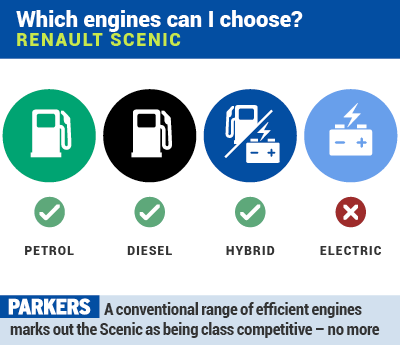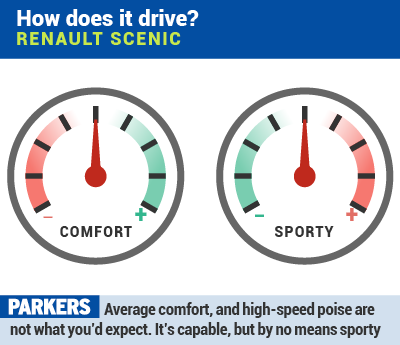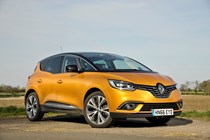
Renault Scenic Estate (2016-2019) engines, drive and performance
.jpg)
- Three diesels
- Two petrols
- One hybrid manual diesel
At launch, a choice of six engines are available along with either a six-speed manual gearbox (which we found acceptable yet with a predictable degree of Renault notchiness) or a twin-clutch automatic.
Petrol power
- TCe 115 – 1.0-litre, 115hp, 190Nm, turbo petrol, six-speed manual. 0-62mph in 12.3 seconds, max speed 115mph, 48.7mpg, 129g/km CO2
- TCe 130 – 1.2-litre, 130hp, 205Nm turbo petrol, six-speed manual. 0-62mph in 11.4 seconds, max speed 118mph, 48.7mpg, 129g/km CO2
The 1.2-litre turbo petrol engine is a reasonably refined unit that doesn’t struggle as much as expected to heft this size of car around. It is eager to rev, but even so, performance figures are never going to re-shape your face, and it’s happiest ambling in a cruise.
We’ve yet to drive the 1.0-litre at time of writing.

Diesel engines
- dCi 110 – 1.5-litre, 110hp, 260Nm turbodiesel, six-speed manual or dual-clutch auto. 0-62mph in 11.4 seconds, max speed 118mph, 72.4mpg, 100g/km CO2
- dCi 130 – 1.6-litre, 130bhp, 320Nm turbodiesel, six-speed manual. 0-62mph in 11.4 seconds, max speed 118mph, 62.7mpg, 116g/km CO2
- dCi 160 – 1.6-litre, 160hp, 380Nm turbodiesel, dual-clutch auto. 0-62mph in 11.4 seconds, max speed 118mph, 62.7mpg, 118g/km CO2
While we haven’t driven the two lower-powered diesels, the 160hp mated to a smooth, twin-clutch automatic transmission feels a better fit for three reasons. F
irstly, it boasts better low-down torque for greater urgency in every driving scenario. Secondly, the Scenic’s family outing character lends itself ideally to an automatic gearbox; and, thirdly, the diesel doesn’t have to try so hard to maintain a high-speed cruise, and is therefore quieter.
Unusual diesel hybrid manual model
- dCi 110 Hybrid Assist – 1.5-litre, 110hp, 260Nm Hybrid Assist turbodiesel with 10kW electric motor, six-speed manual. 0-62mph in 11.4 seconds, max speed 118mph, 80.7mpg, 92g/km CO2
The Hybrid Assist engine is an affordable way for Renault to enter the hybrid arena. Rather than building the electric motor into the gearbox, it takes the place of the alternator alongside the engine, and takes power from an 11kg lithium-ion battery pack under the loadspace deck astern.
Tax-significant 8-10% reduction in fuel consumption and CO2 emissions aside, Renault quotes identical performance figures for this unit and the standard 110hp turbodiesel, suggesting the extra 44kg weight of hybrid componentry balances out any performance advantage. A brief drive does however suggest it adds sprightliness in the urban environment, thanks to an electric motor’s ability to generate maximum torque from zero revs.
- Slow steering masks excellent handling
- Unashamedly large car, and hard to place
- Good handling with familiarity
Wider front and rear tracks than those of the previous model help shackle body roll to a degree, but in order to keep the rubber cladding those handsome 20-inch alloys affordable and not too detrimental to fuel consumption, the tyres are narrower than their diameter would suggest, with inevitable implications for grip levels.

On the open road, the steering is precise and accurate enough without offering over-much communication. If hustled along in a manner not fitting its role as family car, the Scenic acquits itself perfectly well, with no unpleasant surprises lurking at the extremes of grip. It takes familiarity to gain the confidence to drive it quickly on B-roads (if that’s your thing), but once dialled in, the Scenic can be quite a fun thing.
At city speeds, we struggled to locate the front corners of the Renault Scenic. The angle of the windscreen pillar pushes the glazing so far forwards that the dash top stretches off into the middle-distance. Multi-storey car park work left us wincing in fear of alloy wheel damage at every sharp-kerbed turn.


.jpg)
.jpg)
.jpg)
.jpg)
.jpg)
.jpg)
.jpg)
.jpg)
.jpg)
.jpg)
.jpg)
.jpg)
.jpg)
.jpg)
.jpg)
.jpg)
.jpg)
.jpg)
.jpg)
.jpg)
.jpg)
.jpg)
.jpg)
.jpg)
.jpg)
.jpg)
.jpg)
.jpg)
.jpg)
.jpg)
.jpg)
.jpg)
.jpg)
.jpg)

.jpg)
.jpg)
.jpg)
.jpg)

.jpg?quality=50)
.jpg?quality=50)
.jpg?quality=50)
.jpg?quality=50)
.jpg?quality=50)
.jpg?quality=50)
.jpg?quality=50)
.jpg?quality=50)
.jpg?quality=50)
.jpg?quality=50)
.jpg?quality=50)
.jpg?quality=50)
.jpg?quality=50)
.jpg?quality=50)
.jpg?quality=50)
.jpg?quality=50)
.jpg?quality=50)
.jpg?quality=50)
.jpg?quality=50)
.jpg?quality=50)
.jpg?quality=50)
.jpg?quality=50)
.jpg?quality=50)
.jpg?quality=50)
.jpg?quality=50)
.jpg?quality=50)
.jpg?quality=50)
.jpg?quality=50)
.jpg?quality=50)
.jpg?quality=50)
.jpg?quality=50)
.jpg?quality=50)
.jpg?quality=50)
.jpg?quality=50)
.jpg?quality=50)
.jpg?quality=50)
.jpg?quality=50)
.jpg?quality=50)